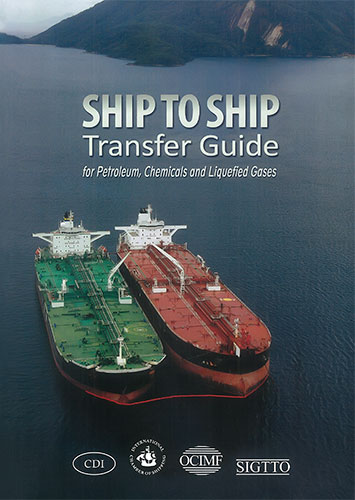Ship to Ship Transfer Guide for Petroleum, Chemicals and Liquefied Gases. –†—Г–Ї–Њ–≤–Њ–і—Б—В–≤–Њ –њ–Њ —В—А–∞–љ—Б–њ–Њ—А—В–Є—А–Њ–≤–Ї–µ –љ–µ—Д—В–Є, —Е–Є–Љ–Є–Ї–∞—В–Њ–≤ –Є —Б–ґ–Є–ґ–µ–љ–љ—Л—Е –≥–∞–Ј–Њ–≤
–Ш–Ј–і–∞–љ–Є–µ –љ–∞ –∞–љ–≥–ї–Є–є—Б–Ї–Њ–Љ —П–Ј—Л–Ї–µ
The Guide provides advice for Masters, Marine Superintendents and others, such as STS service providers and transfer organisers, involved in the planning and execution of STS operations. Particular attention is given to the effective planning of operations and aspects including risk assessment, ship compatibility, and the management of workloads to minimise fatigue.
Contents
Foreword
Glossary
Abbreviations
Bibliography
Section 1 General principles
1.1. Introduction
1.2. Background
1.3. Scope
1.4. Risk assessments
1.5. Control of operations
1.5.1. General
1.5.2. Manning for ship to ship operations and the prevention of fatigue
1.6. Role of a ship to ship superintendent
1.7. Person in overall advisory control
1.8. Training and familiarisation of ship's personnel
1.9. Security
1.9.1. Security on multiple vessels
Section 2 Conditions and requirements
2.1. Ship to ship compatibility
2.1.1. General
2.1.2. Ship to ship transfer operations involving vessels of a similar length
2.1.3. Use of dumb barges
2.2. Notification to and approval from authorities
2.2.1. MARPOL Annex I cargoes
2.2.2. Chemical cargoes
2.2.3. Other cargoes
2.3. Transfer area
2.4. Environmental conditions
2.4.1. Cold weather precautions
2.4.2. Ship to ship operations in ice conditions
2.4.3. Cargo sloshing considerations
2.5. Quality assurance of ship to ship service providers
Section 3 Safety
3.1. General
3.2. Risk assessment
3.2.1. Risk assessment of transfer location
3.2.2. Risk assessment of ship to ship operation
3.3. Personal protective equipment and life saving appliances
3.4. Use of checklists
3.5. Material safety data sheets
3.6. Gas accumulation on open decks
3.7. Action in case of infringement of safety
3.8. Action in case of cargo leakage
3.9. Helicopter operations
3.10. Safety during cargo transfer
3.10.1. Smoking and naked lights
3.10.2. Earths on electrical switchboards
3.10.3. Machinery operations
3.10.4. Electrical isolation
3.10.5. The use of radio and satellite communication equipment
3.10.6. Radar use
3.10.7. Readiness of fire-fighting equipment
3.10.8. Electrical storms
3.10.9. Galley stoves
3.10.10. Accommodation openings
3.10.11. Unauthorised craft
Section 4 Communications
4.1. General communications
4.2. Language
4.3. Pre-arrival communications
4.3.1. Information required from the ships
4.3.2. Advice to be given to the ships by the ship to ship organisers
4.4. Navigational warnings
4.5. Communications during approach, mooring and unmooring
4.6. Communications during cargo transfer operations
4.7. Procedures for communication failure
Section 5 Operational preparations
5.1. General
5.2. Joint plan of operation
5.3. Preparation of ships
5.4. Lightering support vessels
5.5. Navigational signals
Section 6 Manoeuvring and mooring
6.1. Basic principles
6.2. Manoeuvring alongside at sea with two ships under power
6.2.1. General advice for controlling the two ships
6.2.2. Advice for manoeuvring alongside
6.2.3. Manoeuvring a combined two ship system to anchor
6.2.4. Underway transfer
6.3. Manoeuvres with one ship at anchor
6.4. Manoeuvring for in port operations
6.5. Manoeuvring with one ship alongside a terminal
6.6. Mooring operations
6.6.1. Mooring plans
6.6.2. At sea mooring operations
6.6.3. In port mooring operations
Section 7 Procedures alongside
7.1. Pre-transfer procedures
7.2. Responsibility for cargo operations
7.3. Planning for cargo transfer
7.4. Cargo transfer-general guidance
7.4.1. Vapour balancing - general considerations
7.5. Operations after completion of cargo transfer
7.6. Bunkering and storing
Section 8 Unmooring
8.1. Preparations for unmooring
8.2. Unmooring procedure
8.2.1. Unmooring after underway transfer
8.2.2. Unmooring while one ship is at anchor
8.2.3. Unmooring from a ship alongside a terminal
8.2.4. Unmooring using quick release arrangements
Section 9 Equipment
9.1. Fenders
9.1.1. Fenders used for at sea transfers
9.1.2. Reference guide for fender selection for at sea transfers
9.1.3. Fender requirements
9.1.4. Fenders used for in port transfers
9.1.5. Low pressure fenders
9.1.6. Ribbed fenders
9.1.7. Foam filled fenders
9.2. Cargo transfer hoses
9.2.1. Hose standards
9.2.2. Hose length
9.2.3. Pressure ratings and flow velocities
9.2.4. Hose handling
9.2.5. Hose connection
9.2.6. Hose inspection and testing
9.2.7. Marking
9.3. Mooring equipment
9.4. Personnel transfers - at sea operations
9.4.1. Suitability of lifting equipment
9.5. Personnel transfers - in port operations
9.6. Lighting
9.7. Ancillary equipment for ship to ship operations
9.8. Equipment noise levels
Section 10 Emergencies
10.1. Contingency planning and emergency response procedures
10.2. Emergency signal
10.3. Emergency situations
10.4. Examples of potential emergencies
10.4.1. Emergencies during manoeuvring
10.4.2. Procedures in the event of gas accumulation on deck
10.4.3. Accidental cargo release
10.5. Shipboard Oil Pollution Emergency Plan, Shipboard Marine Pollution Emergency Plan (SMPEP) and Vessel Response Plan (VRP)
10.6. State of readiness for an emergency
10.7. Cessation of transfer operations as a precautionary measure
Appendices
A Additional considerations for ship to ship transfers involving MARPOL Annex I cargoes (crude oil and petroleum products)
–Т Additional considerations for ship to ship transfers involving MARPOL Annex II cargoes (chemicals)
–° Additional considerations for ship to ship transfers involving liquefied petroleum gas cargoes
D Additional considerations for ship to ship transfers involving liquefied natural gas cargoes
E Operational/safety checklists
F Example checklist for personnel transfers by crane
G Example checklist for transfers involving vapour balancing
H Fender selection calculation
I Considerations applicable to reverse lightering operations
J Guidance for connection of individual hose lengths to assemble a hose string
K Guidance on risk assessment processes
L Example liquefied natural gas ship to ship transfer compatibility questionnaire




